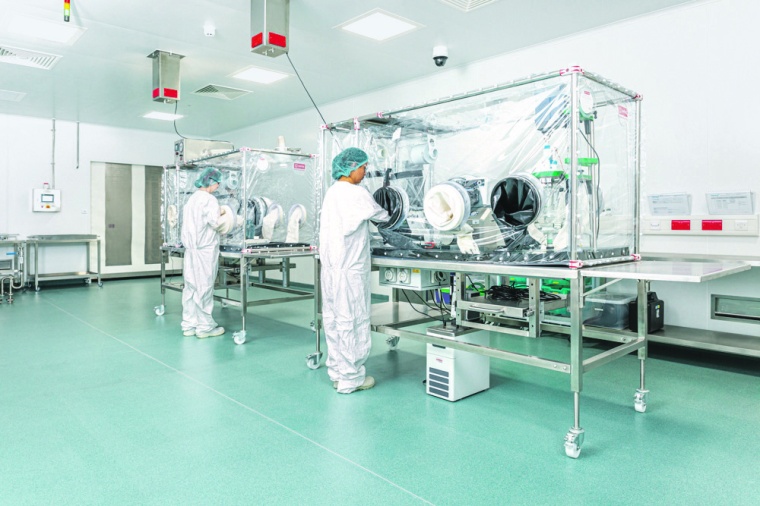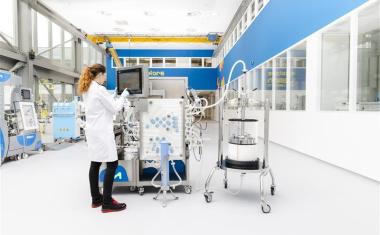Containment Solutions for HPAPI Manufacturing
Clear incentive for drug manufacturers to equip their production facilities with the capacity to process highly potent active pharmaceutical ingredients (HPAPIs). HPAPIs now account for 25% of all drugs produced globally, with some analysts projecting that it will reach a value of $40 billion by 2027.
This projected expansion shows the potential of the market. However, safety and regulations must be followed for successful growth, as HPAPIs are notoriously difficult to handle.
With several major oncological drugs also due to go off patent over the next few years — including Nilotinib in 2024, Pomalidomide in 2025 and Enzalutamide in 2026 — “HPAPI ready” businesses will be free to make bids for their manufacture.
These oncological drugs are used by healthcare providers to target specific types of cancer. Nilotinib, for example, combats chronic myeloid leukemia, a cancer of the blood cells, while Enzalutamide is a treatment for advanced prostate cancer.
While safe to administer to patients in a targeted way, the high potent nature of the ingredients can prove extremely harmful for the workers involved in their manufacture if they are not handled appropriately. Any mistakes made during the production process could result in life-changing aftereffects for the operators.
For this reason, it is critical that manufacturers can demonstrate to authorities, such as the European Medicines Agency (EMA) — which is responsible for the scientific evaluation, supervision and safety monitoring of medicines across the EU — that they can work with highly potent ingredients safely. They will need to show that their employees will be protected at all times and, equally important, that they can also prevent any product cross contamination when handling them.
Growth In Demand Across Europe
As the demand to meet HPAPI requirements increases, more drug manufacturers are focusing on how they can achieve appropriate safety standards with the equipment they are using — especially in emerging economies, such as in Turkey and Poland.
The deployment of containment solutions has become critical for these businesses as they look to satisfy regulators by demonstrating the quality, safety and repeatability of their production processes.
So, what is the best way for those businesses looking to become ‘HPAPI ready’ to install containment capabilities? Should manufacturers build entirely new facilities, or does it make more sense to convert their existing production lines?
Converting Existing Facilities
For sure, the fastest, and most cost-effective, approach would be to retrofit existing facilities. This can be achieved by installing flexible containment technology that can be made bespoke to the needs of each manufacturer. Flexible solutions are designed for single use and can be easily deployed to protect both the user and the product in a contained environment.
This technology allows companies to take on contracts for smaller batches of precision medicines at short notice whilst avoiding large up-front capital expenditure and ongoing equipment depreciation.
This would also enable manufacturers to easily move from open handling manufacturing processes to contained environments that can manage the increased toxicity involved in HPAPIs. Companies can simply contain key parts of their existing manufacturing process — such as the weighing, mixing and milling elements. In fact, 98% of all existing process equipment can now be retrofitted with flexible containment technology.
As these solutions are bespoke to the manufacturer, each one can be designed to have minimal impact on existing standard operating procedures (SOPs). This work can be completed within the space of a few days, at a low cost, to prevent disruption.

Building New Facilities
When it comes to the design and build of new facilities, businesses have traditionally opted to deploy rigid isolators. This remains a popular choice — particularly when they are producing larger batches of the same drugs on an ongoing basis.
However, as manufacturers look to scale up HPAPI production, we are increasingly seeing businesses choosing to incorporate flexible containment solutions at their new build sites too.
There are five key reasons why they are looking to include these flexible alternatives:
- Cleaning and cleaning validation: With a flexible containment approach, manufacturers can remove and incinerate disposable elements, such as single use glove bags — and this greatly reduces the cleaning and cleaning validation process.
This validation is especially important when working with HPAPI drugs, where cleaning can mean going down to the submicron level to reduce traces of a compound. The other key advantage to using disposable elements is that the risk of cross-contamination is removed. - Proven safety: Companies that have previously used flexible containment to retrofit sites are more likely to deploy flexible containment on new sites (compared to companies new to this technology) as their own tests have confirmed the equipment meets safety standards.
Flexible solutions have been independently tested and proven to achieve less than 1 µg/m3 (OEB 5), supporting the manufacturing of products with OELs in the nanogram range. - Compliant and adaptable: Flexible containment technology is capable of controlling humidity, temperature, oxygen degradation and UV light management, by integrating automated and non-automated control systems.
This is opening up the possibility of working with a wider range of drugs, including those that are sensitive to light, such as dacarbazine. The adaptability of the technology also means that products can be consistently produced and controlled in line with the quality standards laid out by good manufacturing practice (GMP) regulation. - Change of use: Flexible containment ensures minimal downtime with simple engineering change out between non-potent and highly potent compounds.
When not required, framework and control systems can be easily stored away until they are needed again — while the protective film can be disposed of and replaced after each use. - The financial case: Flexible containment helps businesses to avoid the large capital expenditure that comes with installing rigid isolator systems. The cost difference between a contained rigid system and flexible system is tenfold. If you were to build a rigid process isolator costing around £100,000, an equivalent retrofitted in-process flexible isolator would typically cost £10,000 — and achieve the same containment levels.
However, perhaps the biggest cost benefits are the savings made through the cleaning validation process. This is not so much due to the cost of the cleaning itself, but through the reduced downtime at the production facilities. Manufacturers are no longer losing days while rigid isolators are cleaned and tested between batch runs.
As businesses equip themselves to meet growing demand for HPAPI drugs, the decisions they take around containment will have implications from a safety, regulatory and financial perspective.
While rigid isolators still have a role to play for manufacturers that are consistently producing the same drugs, others require greater agility.
Flexible containment solutions are providing these businesses with the ability to cut down lead times for customers, without compromising safety standards.
This capacity to produce smaller batches of drugs much faster, and keep costs low, is providing a crucial differentiator in what is a competitive, fast-growing market.
Author: Mark Arnold, Managing Director, Onfab, Middlewich, UK

















